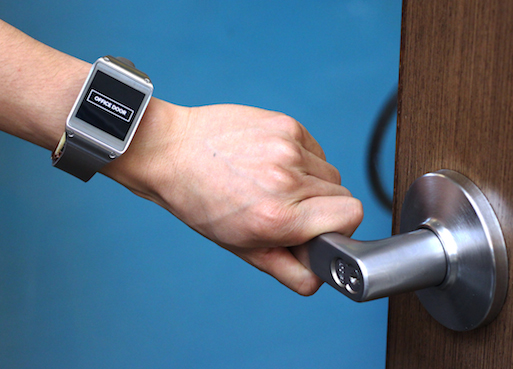System Recognizes Objects Touched by User, Enabling Context-Aware Smartwatch Apps Carnegie Mellon, Disney Method Exploits Conductivity of Human Body
Byron Spice (Carnegie Mellon) and Jennifer Liu (Walt Disney Imagineering)Monday, November 9, 2015Print this page.

A new technology developed by Carnegie Mellon University and Disney Research could enable smartwatches to automatically recognize what objects users are touching — for instance, whether the wearer is using a laptop, operating a saw, or riding a motorcycle — creating new opportunities for context-aware apps.
The technique, called EM-Sense, takes advantage of the body's natural electrical conductivity to detect whether a person is touching an electrical or electromechanical device and, based on the distinctive electromagnetic noise emitted by such devices, automatically identify the object.
"This could be a great feature for smartwatches, making them much smarter than before," said Gierad Laput, a Ph.D. student in Carnegie Mellon's Human-Computer Interaction Institute (HCII). A smartwatch equipped with EM-Sense would have a much more detailed understanding of what the user is doing than is possible with common mobile sensors, such as accelerometers or pulse monitors, he added.
The smartwatch therefore could automatically start a timer when the wearer begins using an electric toothbrush, unlock a keyboard without a password when users touch their laptops or play the latest news when breakfast is being prepared. Linking a smartwatch with a smartphone or other mobile device would expand the possibilities even further.
"We are now able to gain a greater contextual understanding of user activities by recognizing what objects they are interacting with," said Alanson Sample, a research scientist at Disney Research. EM-Sense is able to differentiate between scores of objects based on the ambient electromagnetic noise they emit, so objects need not be modified or have RFID tags for the technique to work.
The researchers will discuss EM-Sense at UIST 2015, the ACM Symposium on User Interface Software and Technology, Nov. 8–11, in Charlotte, N.C.
"By extending the Internet to physical objects — what's being called the Internet of Things (IoT) — we are creating new ways for people to interact with the world around them," said Jessica Hodgins, vice president of Disney Research. "EM-Sense can make the IoT experience even richer by enabling people to get information or additional functionality simply by touching everyday objects."
The human body serves as an antenna for EM-Sense. From any body part an object touches, its distinctive electromagnetic emissions propagate through the body to an electrode worn at the wrist. Kitchen appliances, power tools, electronic scales and door handles with electrically triggered locks are among the items that can be detected and identified. It's even possible to differentiate between different models of cell phones.
Laput said the proof-of-concept sensor was built with off-the-shelf components, principally a small, software-defined radio. A smartwatch would provide the perfect platform, he added, because the watch is in contact with the skin and also houses a highly capable computer for deciphering signals and running apps.
The researchers can also filter out background noise, so the technique recognizes powered devices at any location. The technique can also work with large, non-powered conductive objects, such as doors, ladders and other structural elements.
In addition to Laput and Sample, the research team included Chouchang Yang, a post-doctoral researcher at Disney; Chris Harrison, assistant professor of Human-Computer Interaction; and Robert Xiao, a Ph.D. student in the HCII.
For more information and a video, visit the project website.
Carnegie Mellon is a private, internationally ranked research university with programs in areas ranging from science, technology and business, to public policy, the humanities and the arts. More than 13,000 students in the university's seven schools and colleges benefit from a small student-to- faculty ratio and an education characterized by its focus on creating and implementing solutions for real problems, interdisciplinary collaboration and innovation.
Disney Research is a network of research laboratories supporting The Walt Disney Company. Its purpose is to pursue scientific, and technological innovation to advance the company's broad media and entertainment efforts. Disney Research is managed by an internal Disney Research Council co-chaired by Disney-Pixar's Ed Catmull and Walt Disney Imagineering's Bruce Vaughn, and including the directors of the individual labs. It has facilities in Los Angeles, San Francisco, Pittsburgh, Boston and Zurich. Research topics include computer graphics, video processing, computer vision, robotics, radio and antennas, wireless communications, human-computer interaction, displays, data mining, machine learning, and behavioral sciences.
Byron Spice | 412-268-9068 | bspice@cs.cmu.edu
